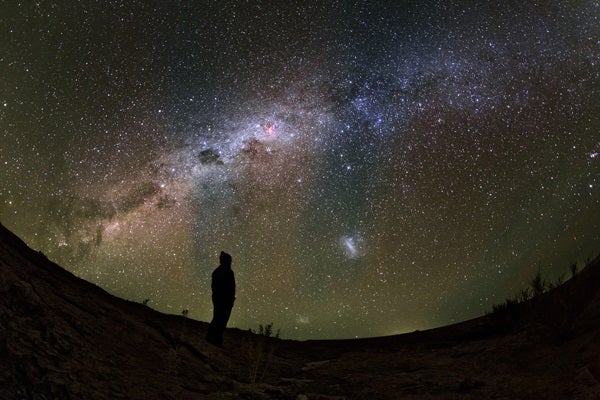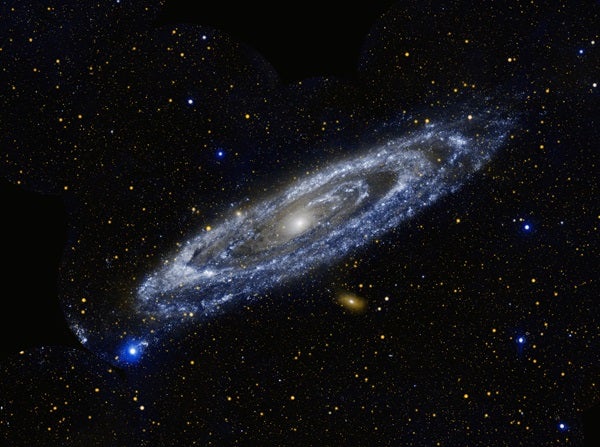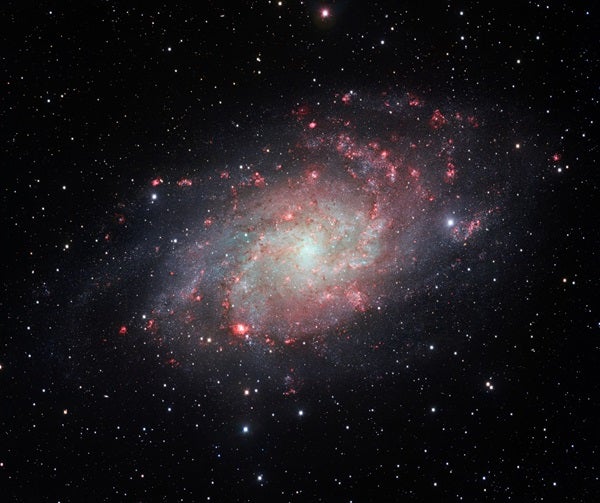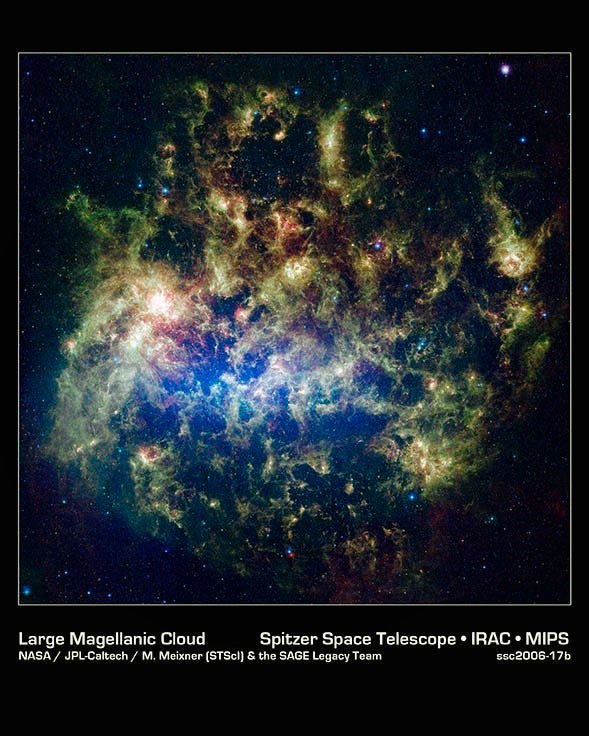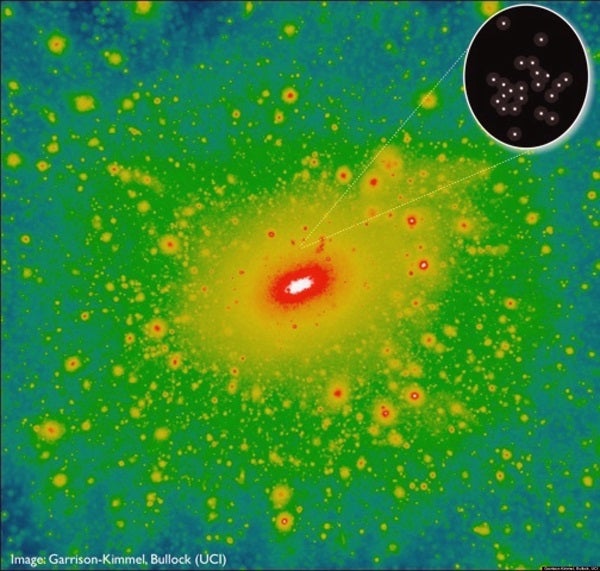The Milky Way Galaxy is like a hilltop village, according to astronomer Andrew Fox. “At nighttime you can see torches shining in two nearby villages, the Magellanic Clouds, and a more distant one, Andromeda,” he says. “For a long time, those were the only other villages known. Then, one day, someone put two lenses together to make a telescope, looked round, and saw many tiny villages scattered around the surrounding hills and realized that the maps had to be redrawn. That’s the Local Group — it’s where we live.”
For most of human history, it was inconceivable that anything existed beyond the Milky Way. After all, the Milky Way is our home galaxy, and its billions of stars provided enough of a nighttime show to fascinate stargazers for millennia. Even now, in the era of space-based telescopes and sensitive cameras, backyard and professional astronomers alike can easily devote lifetimes to studying the Milky Way and its planets, stars, and nebulae.
But a peek over the celestial fence beyond the Milky Way’s tenuous halo yields a rich view of the nearby universe and galaxy evolution in progress.
The approximately 85 gravitationally bound galaxies near the Milky Way are collectively known as the Local Group. This population of galaxies, spread over roughly 10 million light-years, encompasses not only the Milky Way and several bright galaxies visible to the naked eye, but also many much smaller galaxies that dominate the Local Group by number. By studying the Local Group, astronomers can observe galaxies in their entirety, no longer confined to understanding a galaxy from the inside out.
Follow the stream
Astronomers on Earth have front-row seats to the show of galaxy formation in the Local Group. Comparatively puny galaxies often collide with more massive galaxies, their meager stockpiles of gas and dust being absorbed into the larger system of stars. Dwarf irregular galaxies, as their name suggests, are low in mass and lack geometrical structure. They’re visually unimpressive and resemble jumbles of stars — blink and you’ll miss them — with not a spiral arm in sight. Dwarf irregular galaxies in the Local Group can have just a few thousand stars, which makes them downright pint-sized compared with the Milky Way and its hundreds of billions of stars. Even so, astronomers are keen to better understand these featherweights of the cosmos.
“By studying the extremes of any population, we learn more about the population as a whole,” explains Marla Geha, an astronomer at Yale University whose research focuses on the origin and evolution of dwarf galaxies.
The largest and best-known dwarf irregular galaxies in the Local Group are the Large and Small Magellanic Clouds, which look like fuzzy patches in the Southern Hemisphere night sky. The Magellanic Clouds feature prominently in myths: Aboriginal people in Australia tell stories of the Magellanic Clouds alternatively as a man and a woman, hunters, or the ashes of rainbow lorikeets (birds). The Large and Small Magellanic Clouds lie some 160,000 and 200,000 light-years away, respectively, distances slightly greater than the diameter of the Milky Way. Given their relative proximity, each Magellanic Cloud holds the distinction of being one of a smattering of galaxies in which scientists can resolve individual stars.
“Studying the motion and composition of individual stars allows us to build a much more accurate and detailed picture of how a galaxy formed as opposed to studying the combined light from many stars,” Geha says.Hubble Space Telescope images have revealed that the Large Magellanic Cloud is forming stars in dense groups that may be the precursors to globular clusters. Some stars in these groups are thought to weigh as much as 100 Suns; they’re prodigiously bright and emit winds that sculpt nearby gas into bubbles and streamers. These intense star formation sites allow a better understanding of high-mass-star formation, a process common in galaxies that are much farther away than the Local Group.
The Large and Small Magellanic Clouds are gravitationally bound to the Milky Way, but astronomers have yet to agree whether the galaxies have completed several Milky Way orbits or if they’re plunging into our galaxy’s halo for the first time.
“I’d say the jury is still out, chiefly because we don’t know the total mass of the Milky Way very well,” says Fox, the Space Telescope Science Institute astronomer who likened the Milky Way to a hilltop village. “This uncertainty means the Milky Way’s gravity is also not precisely known, which directly affects the orbits of the Magellanic Clouds.”
Regardless of how many times the Magellanic Clouds have orbited the Milky Way, one fact remains certain: The Milky Way’s gravity is ripping both apart. Fox and his colleagues have shown that the Milky Way is stripping away the gas of the two dwarf galaxies and collecting it in a massive cloud known as the Magellanic Stream. This cloud stretches across one quarter of Earth’s sky. Because gas is necessary to form stars, the Milky Way is collecting star-forming material and depriving the Magellanic Clouds of their stellar fuel.
“There has been a lot of attention in recent years about how much gas there is around galaxies and how that gas enters those galaxies to feed star formation,” says Fox. Observations of the Magellanic Stream afford astronomers a close-up view of gas cycling between galaxies, demonstrating that larger galaxies can act like cannibals and literally consume their smaller companions.
Missing metals and mass
Stars are factories for making metals, which astronomers consider to be any element heavier than helium. Some of the metals that stars produce become part of the nebulae from which later generations of stars are born. Therefore, the prevalence of metals in a galaxy — its metallicity — increases over time, at least for galaxies that are actively forming stars. Larger galaxies contain a higher fraction of metals, on average, than smaller ones.
The most massive galaxies in the Local Group — the Milky Way and Andromeda (M31) — contain the highest fractions of metals, which explains the rings on your fingers, your cellphone, and the spoon you used to stir this morning’s coffee.
The dwarf irregular galaxies in the Local Group have metallicities that are much lower. Astronomers refer to low-metallicity galaxies as being “chemically pristine” — they are composed almost entirely of hydrogen and helium, just like the universe shortly after the Big Bang. These systems are like time capsules: They let astronomers study what the early universe looked like before stars “polluted” space with metals.
Researchers discovered one such chemically pristine galaxy in the Local Group using data collected by the Sloan Extension for Galactic Understanding and Exploration (SEGUE), a comprehensive survey of the sky conducted between 2004 and 2008. Astronomers combed through SEGUE data to search for stars that had both similar positions and velocities, hoping to find new galaxies that were much too small and faint to see with current telescopes. In 2009, scientists in the United States and Europe discovered a tiny galaxy in the SEGUE data. The galaxy, which they named Segue 2, orbits the Milky Way but is only 1/500 its size.
Since Segue 2 is relatively nearby — 114,000 light-years away, less than the diameter of the Milky Way — astronomers are able to study the prevalence of metals in its resolved stars. In astronomy, as in sports and politics, studying individuals as op-posed to relying on population averages often leads to new insights. Researchers at the University of Michigan and the Uni-versity of California, Irvine, used the 6.5-meter Magellan Telescope in Chile to study the metallicity of Segue 2’s brightest star, a red giant. They found that the star had a surprisingly low metallicity: only 0.1 percent that of the Sun. These measurements suggest that Segue 2 has not experienced much star formation, which other observations confirm.
“Right now, Segue 2 has a few thousand stars, and it took a few hundred million years to form them,” says Evan Kirby, an astronomer at the California Institute of Technology who studies Segue 2. “So that’s an average star formation rate of 0.00001 stars per year, which is pathetic.”
Segue 2 is peculiar in another respect: its mass (or lack thereof). Most galaxies contain copious amounts of dark matter, a mysterious substance that interacts gravitationally with other matter but does not emit, reflect, or scatter light. Typical galaxies like the Milky Way have 10 times as much dark matter as normal matter. Less massive dwarf galaxies have relatively more dark matter, up to 1,000 times as much as normal matter. When Kirby and his team first looked at Segue 2, they expected it to also have lots of dark matter. They studied how its stars moved using the Keck II Telescope in Hawaii and inferred that the ratio of dark matter to normal matter in Segue 2 was at most 300 to 1 — far less than predicted.
“The small ratio potentially indicates that the Milky Way has stripped off some of Segue 2’s dark matter,” Kirby says. The observations revealed that the total mass of Segue 2 — including dark matter — was a puny 200,000 times that of the Sun. That may sound like a lot of mass, but it’s actually 10 million times less massive than the Milky Way.
Segue 2 is a ladybug to the Milky Way’s Volkswagen Beetle.
“These systems have all the properties of galaxies but ridiculously few stars. That a galaxy this puny can form at all is a surprise to me,” Geha says.
And it might not be alone. Astronomers suspect that the Local Group could harbor far more galaxies than the roughly 85 that are currently known. “For every galaxy that we see, there could be a couple hundred that we don’t see,” Kirby says. “To be fair, most of these unseen ‘galaxies’ may not have any stars — just dark matter — which makes it questionable to call them galaxies.”
Searches are underway to find such dark- matter-dominated galaxies, and earlier this year a team of astronomers led by Sukanya Chakrabarti at the Rochester Institute of Technology announced four stars possibly belonging to a Local Group galaxy consisting mostly of dark matter.
Toward the Princess
The Milky Way’s gravitational entourage — the Magellanic Clouds, Segue 2, and other nearby dwarf irregular galaxies — isn’t unique in the Local Group. The Andromeda Galaxy, some 2.5 million light-years away, has several orbiting satellite galaxies as well. This fact shouldn’t come as a surprise since the Milky Way and M31 are the largest galaxies in the Local Group.
“As one of the two most massive members of the Local Group, Andromeda drives much of the evolution of the group,” explains Benjamin Williams, an astronomer at the University of Washington who studies stellar populations within nearby galaxies. In fact, M31 shows evidence for even more interactions with its cadre of gravitational groupies than the Milky Way. “It has a more structured stellar halo that is full of streams, indicative of a more violent past,” Williams says. “Its satellite galaxies have much less current star formation, also suggestive of more interactions.”
Earlier this year, astronomers at the University of Notre Dame and the Uni-versity of Wisconsin-Madison published the discovery of a massive halo of gas around M31. The halo, which they discovered using Hubble, extends halfway to the Milky Way and contains metals such as carbon, oxygen, and silicon, some of which may have been stripped from satellite galaxies that merged with Andromeda.
Demonstrating that large galaxies consume smaller galaxies is more than just a morbid pursuit, however. “Observing a dwarf galaxy getting stretched out until it disrupts into the smooth outskirts of the Milky Way or Andromeda is to see galaxy growth in action,” Kirby says. Astronomers like Kirby want to understand how galaxies assemble over time into the ones we observe today without having to wait the roughly 5 billion years before the Milky Way and Andromeda collide.
“That collision will erase the spiral arms of the Milky Way and Andromeda, and we will be left with one mostly featureless elliptical galaxy,” Kirby says. But the dwarf irregular galaxies in the Local Group aren’t destined for such drastic collisions. “Most of the dwarf irregulars will continue orbiting their larger hosts — even after the big collision — and their stellar populations will remain unchanged.”
When the Milky Way and Andromeda do finally collide, the supermassive black hole at the center of each galaxy will orbit around each other, releasing copious amounts of energy. Supermassive black holes are relatively rare in the Local Group, however: Out of the roughly 85 galaxies, only three — the Milky Way, Andromeda, and a dwarf elliptical satellite of Andromeda known as M32 — show evidence for such a monster. It’s no coincidence that these three galaxies are also among the most massive systems in the Local Group. “The smallest galaxies with known central black holes typically have stellar masses of about 1 billion solar masses,” explains Kirby. “Most of the dwarf irregulars in the Local Group top out at 100 million solar masses, so there is not yet any evidence for supermassive black holes in these galaxies.”
Cosmic cannibalism appears to be ubiquitous around large galaxies in the Local Group. Even so, some galaxies seem to be remarkably immune to it. The spiral galaxy M33, also known as the Pinwheel Galaxy, is the third-largest galaxy in the Local Group after the Milky Way and M31. It orbits Andromeda yet possesses no central bulge of stars, which is often a telltale sign of previous galactic mergers. Furthermore, its 40 billion stars are arranged in a spiral, a fragile geometry that would have been destroyed by any significant gravitational interactions.
NGC 604, an enormous star-forming region in M33, is evidence that the galaxy contains copious amounts of gas. If the Pinwheel’s gas reservoirs were somehow stripped away by Andromeda at some point in the past, the gas must have been replenished before NGC 604’s first stars began to form several million years ago.
“M33 gives us a nearby subject for learning about disk formation and evolution in a galaxy that experiences little harassment from satellites,” Williams says.
Far away from the Milky Way and Andromeda, the Local Group’s remaining galaxies exist in relative solitude. They’re the last torches before reaching other distant galaxy clusters, which themselves are part of the larger Virgo Supercluster. Astronomers can now study galaxies in our home supercluster in intricate detail using advanced telescopes and cameras, but the hilltop villages of the Local Group still beckon like beacons.

